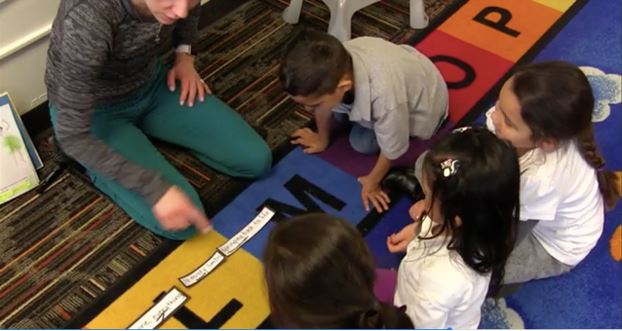According to the National Center for Education Statistics, the percentage of English language learners (ELLs) in PreK-12 in the United States was just over 10 percent or approximately 4.9 million students in 2013-14. The top three languages spoken by ELLs are Spanish, Arabic, and Chinese. The Annenberg Institute notes that the numbers of ELLs in the United States increased by 18% from 2000-01 to 2010-11.
Despite the increasing numbers of ELLs in US schools, when the Common Core State Standards (CCSS) were first published in 2010, they did not include much guidance for diverse student populations. The Standards’ developers did acknowledge the importance of considering the needs of ELLs when implementing the Standards through their release of a brief addendum to the Standards, and there was a separate addendum for special education students, as well.
Nevertheless, that guidance did not provide a roadmap for how the CCSS related to English language proficiency (ELP) or English language development (ELD) standards; it also provided no help for appropriate uses of language for students of different proficiency levels when working toward the CCSS. Subsequently, many voices of ELL teachers, researchers, policymakers, and other practitioners have contributed to the discussion of what we should keep in mind when implementing the CCSS with this unique population of students. TESOL International Association’s Overview of the Common Core State Standards Initiatives for ELLs issue brief (2013) provides an excellent resource to understand the development of the CCSS in general and their implementation for ELLs.
This four-part blog post series will offer guidelines on:
- The Three Shifts and ELLs (in this post)
- Criteria for Curricular Materials Labeled as Appropriate for ELLs
- Where to Find High-Quality Curricular Materials in the Public Domain
- What to Do When High-Level Curricular Materials for ELLs Are Not Available
These blog posts are written for all teachers of ELLs, administrators, and other practitioners and can be used as a thrifty reference guide for collaboration, curriculum planning, and professional development.
When thinking of what is important when implementing the CCSS with ELLs at a very high level, I like to ground my thoughts in the three Shifts in the CCSS for English Language Arts & Literacy and adapt those Shifts to encompass what all teachers must do to address the Shifts with their ELLs. While I recognize that ELLs also take part in CCSS-aligned mathematics instruction, a close examination of how to address the ELA & Literacy Shifts is a good place to start. In addition, the components of the Shifts are transferable to other subject areas.
Three Shifts: What All Teachers of ELLs Must Do, and Strategies
| CCSS for ELA & Literacy Shift |
To Address This Shift, all Teachers of ELLs Must Be Able to… |
Strategies that Cut Across All Shifts |
| Regular practice with complex text and its academic language |
- Analyze complex texts for academic language that might impede ELLs’ comprehension
- Explicitly teach the academic language necessary to comprehend complex texts so that ELLs can draw on these texts to speak and write across content areas
- Choose and adapt supplementary texts in English and/or ELLs’ home language(s) based on ELLs’ reading level, English language proficiency level, background, and culture
- Teach ELLs strategies to determine the meaning of unfamiliar vocabulary words (e.g., cognates, prefixes, roots, suffixes)
- Teach the meanings of words with multiple definitions, idiomatic expressions, and technical terms
|
- Collaborate with ESOL teachers to share expertise, plan instruction and assessment, deliver instruction, and revise lesson plans on an ongoing basis
- Use English language proficiency and CCSS standards to plan instruction
- Scaffold and support instruction for ELLs at different proficiency levels
- Design appropriate classroom assessments so that ELLs can demonstrate what they know and can do
|
| Reading, writing, and speaking grounded in evidence from both literary and informational text |
- Know students’ backgrounds and cultures and integrate their backgrounds and cultures into instruction
- Provide scaffolds and structures so that ELLs can cite evidence from different types of text at different levels of complexity and/or in their home language(s)
- Create text-dependent questions that are scaffolded for students at different levels of English language proficiency
- Teach ELLs the academic language necessary so that they can use evidence from literary and informational text in reading, writing, speaking, and listening
- Provide ELLs with linguistic structures and supports so that they can cite sources, avoid plagiarism, synthesize information from grade-level complex text, and create argumentative and/or persuasive speech and writing
|
| Building knowledge through content-rich nonfiction |
- Activate and/or provide an appropriate amount of ELLs’ background knowledge about the content and structure of nonfiction text
- Integrate ELLs’ background knowledge and culture into instruction to support their comprehension of nonfiction
- Teach ELLs differences between structure of informational text and literary text
- Draw from ELLs’ home-language reading literacy skills as a support as appropriate
- Adapt and/or supplement grade-level complex texts for ELLs at lower levels of English language proficiency while also giving them access to scaffolded grade-level text
|
Staehr Fenner, (2013). Adapted from http://achievethecore.org/content/upload/122113_Shifts.pdf – originally in TESOL (2013) white paper – adapted more for this publication.
Now that you have a sense of what all teachers of ELLs (not only the English as a Second Language teacher) must do to ensure they’re addressing the Shifts, take a minute to reflect on your own practice. What do the Shifts mean for you in your work with ELLs? How are you collaborating with other teachers to draw upon the strengths of ELL students and meet their needs?
About the Author: Diane Staehr Fenner is founder and president of DSF Consulting, a woman-owned small business that supports English learner (EL) achievement by providing technical assistance, professional development, research, and curriculum design to districts, states, and organizations. She earned her Ph.D. in Multilingual/Multicultural Education from George Mason University with an emphasis in Literacy. In addition to her work on policy and practice issues at the national, state, and local levels, she has an extensive instructional background in K-12 education, including ten years teaching and assessing ELs in Fairfax County Public Schools, Virginia as well as experience teaching English as a Foreign Language through a Fulbright Scholarship. Dr. Staehr Fenner is an author of many works in the field of EL education. She authored the well-received Advocating for English Learners: A Guide for Educators (Corwin, 2014). In addition, she writes a popular blog for Colorín Colorado and has recently published articles on EL education for ASCD and the International Literacy Association. She is the lead author of Evaluating ALL Teachers of English Learners and Students with Disabilities: Supporting Great Teaching (Corwin, 2015) and Preparing Effective Teachers of English Language Learners: Practical Applications for the TESOL P-12 Professional Teaching Standards (2012). She frequently presents on the topics of EL advocacy and collaboration, teacher preparation of ELs, and practical strategies for implementing College and Career Ready Standards for ELs at state, national, and international conferences.

















